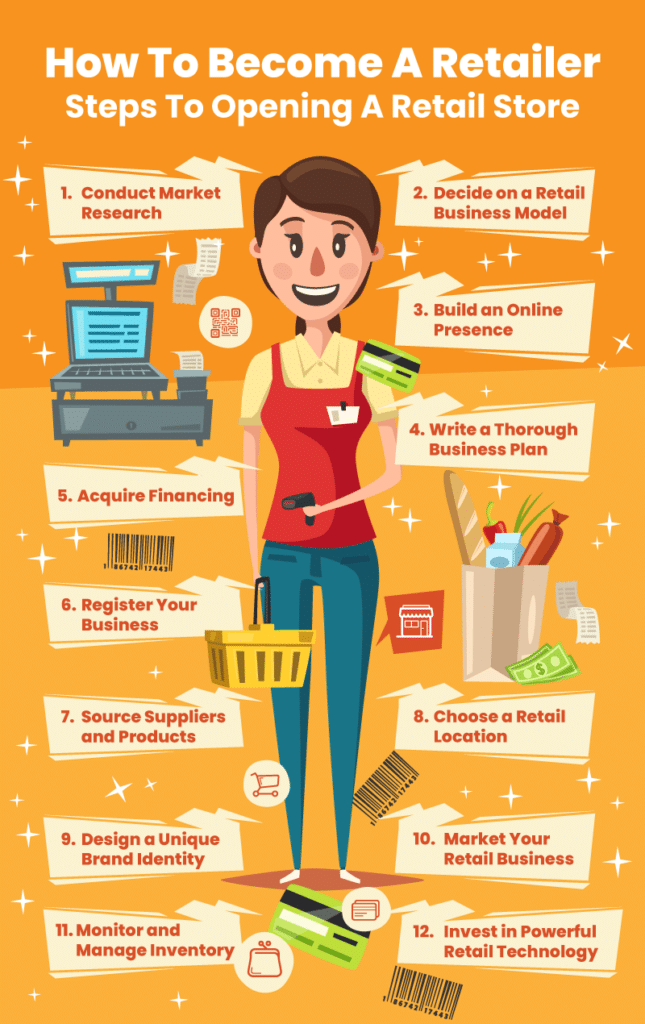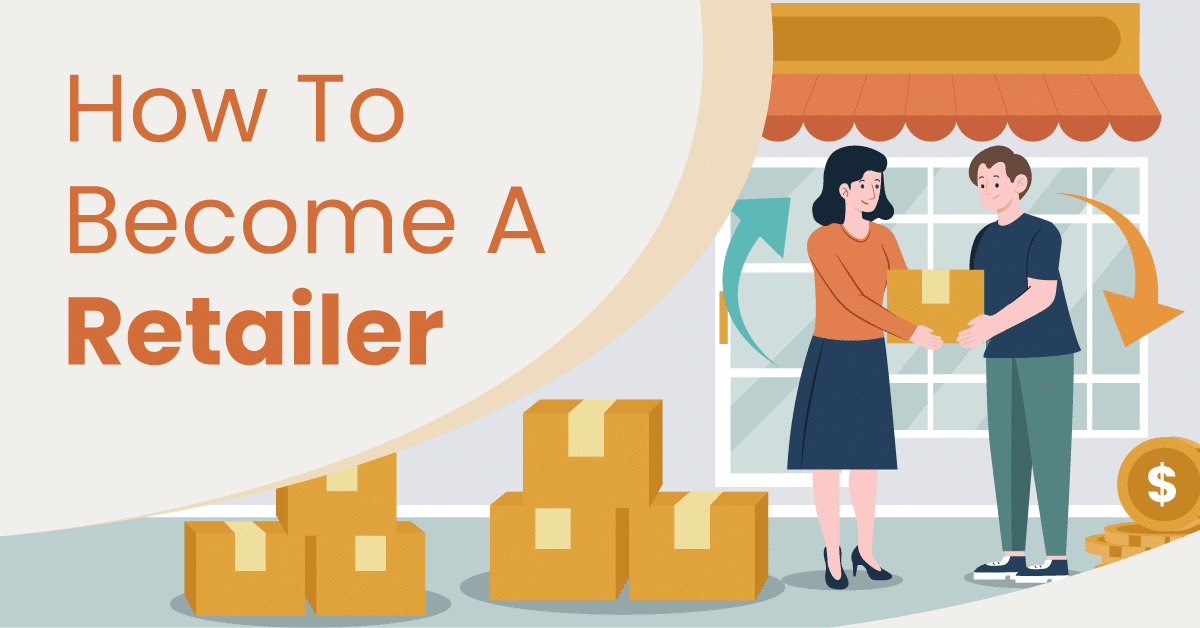
The retail industry continues to grow at an average of 5% annually. Undeniably, becoming a retailer can be a rewarding and lucrative venture. As a retailer, you have the opportunity to connect with customers, offer products and services, and make a significant impact on your community.
However, entering the retail industry requires careful planning, dedication, and a solid understanding of the market and consumer behavior.
This comprehensive guide on how to become a retailer will take you through the essential steps, from conducting market research and creating a business plan to managing inventory and building a solid brand presence.

Steps To Opening A Retail Store
- Conduct Market Research
- Decide on a Retail Business Model
- Build an Online Presence
- Write a Thorough Business Plan
- Acquire Financing
- Register Your Business
- Source Suppliers and Products
- Choose a Retail Location
- Design a Unique Brand Identity
- Market Your Retail Business
- Monitor and Manage Inventory
- Invest in Powerful Retail Technology
Conduct Market Research
Before diving into the retail business, it is crucial to conduct thorough market research. Identify your target audience, assess your product or service demand, and analyze your competition.
Understanding market trends and consumer preferences will help you make informed decisions and differentiate your retail business from others. Make sure you pick a vertical you are familiar with. In addition, have a focused niche or target market; you can always expand it later.
Decide on a Retail Business Model
Choosing between brick-and-mortar (physical stores) and eCommerce (online stores) is critical for any business, as each option offers distinct advantages and challenges.
Despite the rapid growth of eCommerce shopping, in-store shopping still accounts for 85% of retail sales. Brick-and-mortar stores provide a tangible shopping experience, fostering face-to-face customer interactions and immediate product gratification.
They also enable businesses to establish a local presence, targeting specific demographics and engaging with the community. However, they require higher initial investments, ongoing overhead costs, and limited geographical reach.
On the other hand, eCommerce merchandising offers global accessibility, reaching a wider audience and potential customer base. It allows for 24/7 shopping convenience and offers flexibility in managing inventory and expanding product offerings. Nonetheless, eCommerce selling demands a robust online presence, effective digital marketing strategies against more competition, and deeper customer trust in security and delivery.
Build an Online Presence for Omnichannel
Many retail merchants might find the most successful by combining the two channels. It’s easier than ever to start a small eCommerce website or join a third-party selling platform, so supplementing your brick-and-mortar store with online selling may help your business scale.
Hellen S. – Brunswick Bottle Shop
“Having a strong online presence helps retailers reach more people and sell more stuff. It’s like having a store that’s open all the time, where customers can learn about products and shop easily, no matter where they are.”
Integrating brick-and-mortar with eCommerce optimizes customer experience and increases sales. Customers can browse online and make in-store purchases or vice versa, leveraging the benefits of both platforms.
The combination enhances brand visibility, loyalty, and customer satisfaction by catering to shopping preferences. But businesses must maintain consistent pricing, promotions, and product availability across channels for successful integration. It’s crucial to have a retail point of sale that facilitates efficient inventory management systems and offers seamless transitions between online and offline experiences.

Write a Thorough Business Plan
A well-structured business plan is a roadmap for your retail venture. This document will guide you and be integral in seeking funding from investors or financial institutions. Include the following:
Executive Summary:
- Brief overview of the business, its mission, and vision
- Description of products/services offered and target market
Company Description:
- Detailed explanation of the retail business’s background and history
- Legal structure (e.g., sole proprietorship, partnership, LLC)
- Location and facilities
Market Analysis:
- Analysis of the target market, including demographics and buying behavior
- Evaluation of competitors and their strengths and weaknesses
- Identification of market trends and opportunities
Products/Services Offered:
- Comprehensive description of the products/services sold
- Competitive advantage and unique selling points
Marketing and Sales Strategy:
- Marketing plan/budget to reach the target audience (online and offline channels)
- Sales tactics, promotions, and customer retention strategies
Organization and Management:
- Organizational structure and roles/responsibilities
- Background and expertise of the management team
Operations and Logistics:
- Overview of the daily operations and processes
- Suppliers and inventory management strategy
Financial Projections:
- Projected revenue and sales forecasts for the next 3-5 years
- Break-even analysis, funding requirements, and profit margins
Funding Request:
- Amount of funding needed (if seeking external financing)
- Purpose of the funds and how they will be utilized
Acquire Financing
Depending on the scale of your retail operation, you might need financial assistance to start or expand your business. Explore different funding options like personal savings, bank loans, angel investors, or crowdfunding platforms.
One of the major pitfalls for new retail businesses is starting without enough capital. Be realistic about how much money you truly need to finance your business.
Finally, ensure that your business plan showcases the potential for a return on investment to attract funding.
Register Your Business
Choose an appropriate business structure and register your retail business with the relevant authorities. This process involves obtaining licenses and permits specific to your location and industry.
Compliance with legal requirements is vital to avoid any legal issues in the future. Remember that some industries, like alcohol, cannabis, and tobacco, require special licenses and zoning requirements. Be sure to familiarize yourself with all the regulations for your vertical, state, municipality, and even neighborhood/street.
Source Suppliers and Products
Acquiring suppliers and products is critical to running a successful retail business. Retailers search for suppliers through industry trade shows, online marketplaces, and networking events.
Establish relationships with reliable suppliers to ensure consistent product quality, competitive pricing, and timely deliveries. Retailers must also conduct thorough research and analysis to identify market trends, demand patterns, and customer preferences.
Making informed and strategic decisions on the products you carry in your store will lead to more success. Consider your target audience and pricing strategies when looking for products and wholesalers. You want to get the best products possible while ensuring that those products move off the shelves.

Choose a Retail Location
If you opt for a physical store, find a suitable location that aligns with your target audience and complements your product offerings. Consider accessibility and neighboring businesses when choosing your retail space.
Will you be a destination retailer or a convenient location to buy everyday items? In some situations, having a parking lot is a must. In others, proximity to subway stations, other forms of public transit, or in areas with heavy foot traffic increases exposure.
Having enough square footage is also essential. However, finding a balance between spaciousness and efficiency is a must. Decide what makes the most sense for your merchandise, budget, and retail niche.
Design a Unique Brand Identity
A small business retailer can create a compelling brand identity by defining its unique value proposition and target audience. A big part of this is through crafting a distinctive brand logo and color scheme. These visual elements that resonate with a brand’s personality and values will establish a recognizable and memorable brand image.
Maintain consistent messaging and storytelling across all communication channels, including social media, packaging, and in-store displays. This consistency will reinforce the brand’s identity and connect emotionally with customers.
Some stores will choose to do branding themselves. Others can seek out affordable solutions for retail SMBs. There are endless possibilities for third-party design firms with wide-ranging packages and pricing.
Market Your Retail Business
Invest in marketing efforts to promote your retail business. Utilize traditional marketing channels (such as flyers, posters, and local events) and digital marketing strategies (like search engine optimization and social media advertising) to reach a wider audience and drive traffic to your store or website.
Digital Marketing
Digital marketing helps reach a broader audience and can be more cost-effective. By optimizing eCommerce sites for search engines and investing in pay-per-click (PPC) advertising, retailers will increase their online visibility and attract more customers.
Engaging customers through social media helps small businesses show their personality and brand story. On the other hand, email marketing aids in acquiring new customers, promoting products, and offering exclusive deals.
Provide Exceptional Customer Service
Anita R. – La Vega Cigars
“Customer service in retail is all about making shoppers happy. From saying hello to helping with questions, we’re not just doing transactions, we’re making friends. Our goal is to give people such a great experience that they want to tell others about our store.”
To provide exceptional customer service, a retailer should prioritize training and empowering their staff to deliver personalized and attentive assistance. Creating a welcoming and friendly atmosphere in-store and online helps to establish a positive customer experience.
Adding multiple communication channels, such as live chat, email, and social media, allows customers to reach out conveniently. Actively listening to customer feedback, resolving issues promptly, and exceeding expectations are crucial elements in building long-lasting customer relationships and loyalty.
Loyalty and Customer Relationship Management
One way to keep customers engaged is through rewards programs. Customer loyalty has become more and more popular. There are now platforms for just about every retail vertical.
These loyalty programs incentivize clientele to return to stores and show appreciation for being frequent shoppers. One study found that 80% of respondents said they were likelier to continue purchasing from a brand with a good loyalty program.
Monitor and Manage Inventory
Efficient inventory management is critical to the growth of a retail business. Implement inventory tracking systems to avoid stockouts or overstocking. Regularly analyze sales data to forecast future demand and make informed purchasing decisions.
Modern point of sale systems offer advanced inventory management features that streamline retail operations. Integrated barcode scanning, RFID technology, and automatic ordering ensure more accurate and efficient inventory control.
Invest in Powerful Retail Technology
Choosing your point of sale is one of the most important investments you will make when becoming a retailer. Modern POS systems power everything from loyalty and customer relationship management to inventory optimization, eCommerce, and more.
Plus, every time you make a sale, your staff will use the checkout software. Ensure you have the smoothest, fastest, most intuitive retail point of sale with KORONA POS.
Click the button below to learn how to become a successful retailer with our award-winning software.
FAQs: How To Become A Retailer
To become a retailer, you need a clear business plan outlining your target market, the products you intend to sell, and your unique selling proposition. Plus, you’ll need a reliable source of products, adequate start-up financing, and a well-designed marketing strategy. Finally, obtaining necessary permits and licenses should be addressed to ensure compliance with local regulations.
Retailers make money by purchasing products or goods from wholesalers or manufacturers at a wholesale price and then selling them to consumers at a higher retail price. Successful retailers focus on increasing sales, managing inventory efficiently, and providing exceptional customer experiences to drive revenue and profitability. Integrating eCommerce with brick-and-mortar sales also helps retailers increase their revenue.
The revenue of a small retail store can vary significantly based on factors such as location, product selection, customer base, and overall business efficiency. On average, small retail stores earn from $100,000 to $500,000 in annual gross revenue. However, it’s important to note that these figures fluctuate, and success in the retail industry depends on diligent business management.













